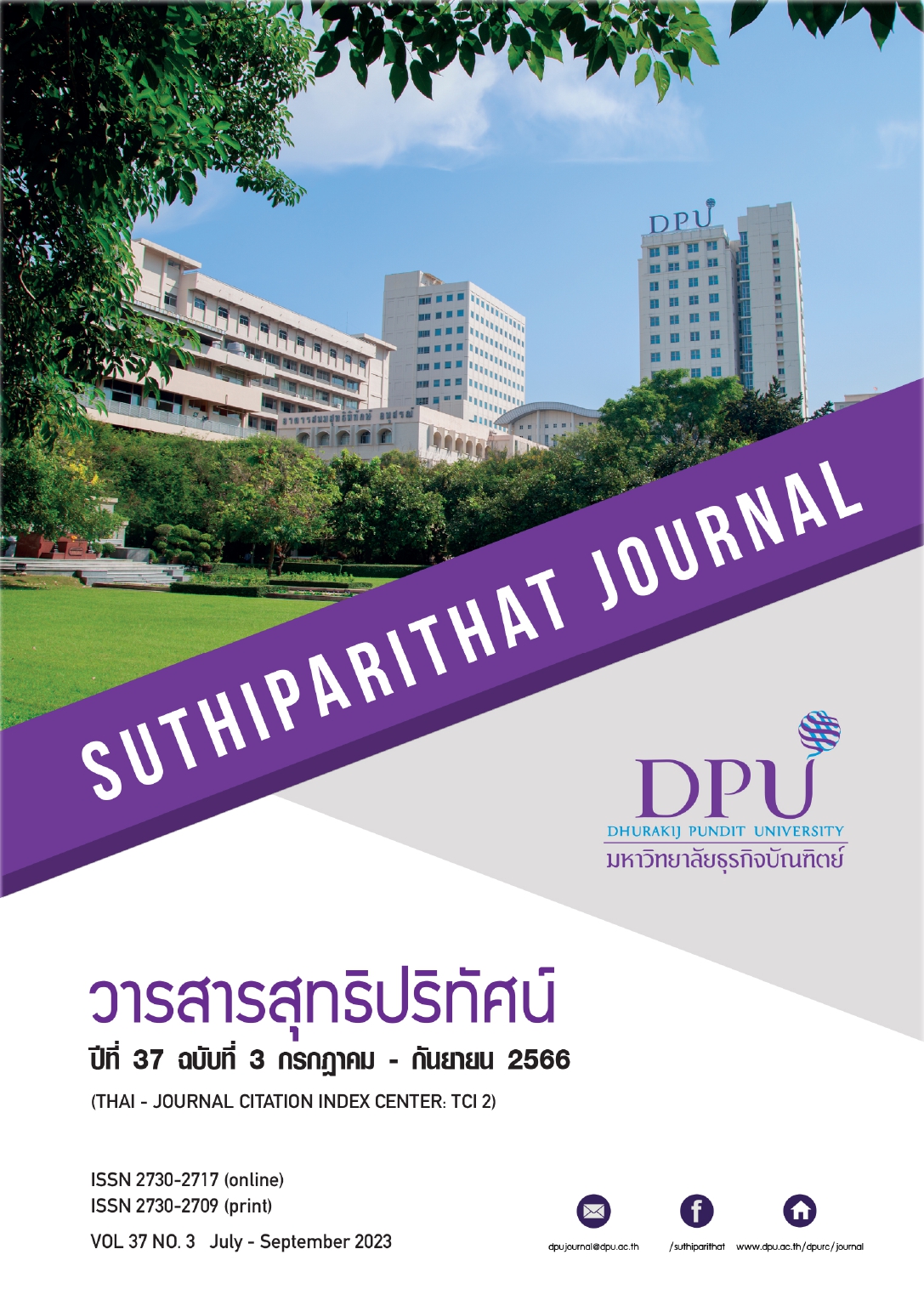WILLINGNESS TO PAY TO IMPROVE THE EXPERIENCE AND INTERNAL SERVICE EFFICIENCY OF THAI PASSENGERS IN SUVARNABHUMI AIRPORT
Keywords:
Willingness to Pay, Contingent Valuation Method, Double Bounded Logit Model, Passenger Luggage DeliveryAbstract
This research aims to 1. assess the value of passengers' willingness to pay for luggage delivery and expedited lane services and 2. to study the relationship between the pattern of luggage delivery by private companies. with delivery by airline with the method of evaluating by using the method of hypothesis Evaluate and use a double bounded CVM questionnaire based on both statistical and qualitative research methods. A study by online questionnaire from 442 informants from users of the Bangkok-airport luggage delivery service. The results showed that 1) Willingness to pay Surcharge for luggage delivery at the airport It was found that 442 samples were willing to pay for the extra charge. Luggage delivery service Bangkok - airport (by airline) decreased by 98 THB, luggage delivery service Bangkok-airport (by private line) increased by 35 baht, and luggage delivery service Bangkok-airport (with tracking system) decreased. Equal to 125 baht and 2. the correlation of this study reflects only 44 people in the income over 100,000 group among the informants. On the other hand, most of the sample groups do not have the capacity to pay for Fast Track Lanes. The results of this research can be applied to develop applications for users to accept more technology.
References
กฤษดา เชียรวัฒนสุข และ สมพล ทุ่งหว้า. (2562). ผลของคุณภาพการให้บริการต่อการตัดสินใจใช้บริการซ้ำของผู้ให้บริการขนส่ง. วารสารเกษมบัณฑิต, 20(2), 92-106. https://so04.tci-thaijo.org/index.php/jkbu/article/view/226498
ชนินทร์ มีโภคี. (2558). เศรษฐศาสตร์อุตสาหกรรม: Industrial organization มหาวิทยาลัยธรรมศาสตร์.
ไชยชนะ จันทรอารีย์, มาเรียม นะมิ, และ อัมพล ชูสนุก. (2559). อิทธิพลของคุณภาพการให้บริการต่อความไว้เนื้อเชื่อใจ ความพึงพอใจ การบอกต่อและการกลับมาใช้บริการซ้ำของลูกค้าโรงพยาบาลพระราม 2. วารสารปัญญาภิวัฒน์, 8(2), 25-40. https://so05.tci-thaijo.org/index.php/pimjournal/article/view/65645
ณิชาภัทร บัวแก้ว และ กฤษดา เชียรวัฒนสุข. (2562). การเปรียบเทียบลักษณะผู้ใช้บริการคุณภาพบริการที่ได้รับและประสิทธิภาพที่ได้รับที่ส่งผลต่อการใช้บริการซ้ำของบริษัทขนส่งเคอรี่เอ็กซ์เพรส จำกัด และบริษัท ไปรษณีย์ไทย จำกัด. วารสารมหาจุฬานาครทรรศน์, 6(4), 1782- 1796. https://so03.tci-thaijo.org/index.php/JMND/article/view/192365
Akerlof, G. A. (1978). The market for “lemons”: quality uncertainty and the market mechanism. In P. Diamond & M. Rothschild (Eds.), Uncertainty in economics (pp. 235-251). Academic Press.
Avcilar, M. Y., & Alkevli, A. (2017). The antecedents of mobile repurchasing intentions: An empirical investigation among Turkish mobile shoppers. International Journal of Business and Management, 12(3), 105-125. https://doi.org/10.5539/ijbm.v12n3p105
Barnett, M., Jermier, J., & Lafferty, B. (2006). Corporate reputation: The definitional landscape. Corporate Reputation Review, 9(1), 26-38. https://doi.org/10.1057/palgrave.crr.1550012
Fombrun, C. J., & Rindova, V. (1996). Who’s tops and who decides? The Social Construction of Corporate Reputations. New York University, Stern School of Business.
Fombrun, C., & Riel, C. V. (1997). The reputational landscape. Corporate Reputation Review, 1(2), 1-16.
Freeman, A. M. (2003). The measurement of environmental and resource values (2nd ed.). Routledge.
Hanemann, W. M. (1984). Welfare evaluations in contingent valuation experiments with discrete responses. American Journal of Agricultural Economics, 66, 332-341. http://dx.doi.org/10.2307/1240800
Hanemann, W. M., Loomis, J., & Kanninen, B. (1991). Statistical efficiency of double-bounded dichotomous choice contingent valuation. American Journal of Agricultural Economics, 73(4), 1255-1263. https://doi.org/10.2307/1242453
Jotikasthira, C., Onputtha, S., & Aimsaard, P. (2020). Customer-contact business strategies affecting organizational reputation of airway businesses. Journal of Logistics and Supply Chain College, 6(2), 129-142. https://so03.tci-thaijo.org/index.php/Logis_j/article/view/243288
Kau, A., & Wan‐Yiun Loh, E. (2006). The effects of service recovery on consumer satisfaction: A comparison between complainants and non-complainants. Journal of Services Marketing, 20(2), 101-111. https://doi.org/10.1108/08876040610657039
Michell, R. C., & Carson, R. T. (1989). Measuring the willingness to pay for environmental resources. In Contingent Valuation: A Critical Assessment (pp. 38-76). North-Holland.
Mitchell, R. C., & Carson, R. T. (1989). Using surveys to value public goods: The contingent valuation method. Resources for the Future.
Rosen, S. (1974). Hedonic prices and implicit markets: Product differentiation in pure competition. Journal of Political Economy, 82(1), 34-55. https://www.jstor.org/stable/1830899
Shapiro, C. (1983). Premiums for high-quality products as returns to reputations. The Quarterly Journal of Economics, 98(4), 659-679. https://doi.org/10.2307/1881782
Stiglitz, J. E. (1986). Economics of the public sector. W. W. Norton & Company.
Downloads
Published
How to Cite
Issue
Section
License
Copyright (c) 2023 Dhurakij Pundit University

This work is licensed under a Creative Commons Attribution-NonCommercial-NoDerivatives 4.0 International License.
Content and information of the article published at Suthiparithat Journal are based on the sole opinions and responsibility of author(s) only. Neither the editorial board involve in......







